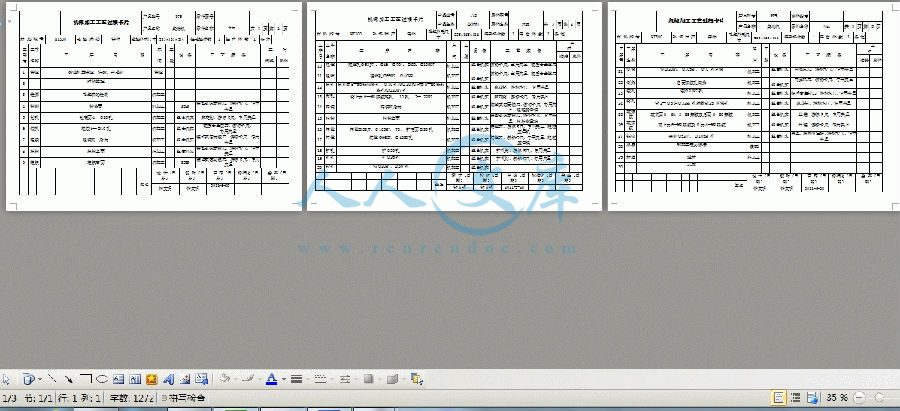175型柴油机缸体的机械加工工艺及组合机床钻前面8—M6螺纹底孔夹具设计【工艺夹具类优秀毕业设计】
【word+5张CAD图纸全套】【工艺过程、工序卡片】【带任务书+开题报告+工作中期检查表+指导教师审阅表+答辩资格审查表+答辩及最终成绩评定表+评阅教师评阅表+外文翻译+实习报告】【40页@正文13200字】【详情如下】【全套设计需要咨询请加QQ1459919609】.bat
A0柴油机缸体零件图1.dwg
A0钻削夹具装配图.dwg
A3的毛坯图.dwg
A3钻削夹具零件下底板.dwg
A4钻模板.dwg
任务书、开题报告及各表.doc
外语文献翻译.doc
封面.doc
机械加工工序卡片.doc
机械加工工艺过程卡片.doc
正文.doc
毕业设计(论文)课题任务书
课题名称175型柴油机缸体机械加工工艺及其组合机床钻孔夹具设计
内容及任务
1、技术要求
设计需保证计算准确,设计说明书应文理通顺、条理清晰、图文并茂。
2、工作要求
认真复习设计有关知识,并查询有关资料、手册,按时保质、保量完成设计任务。设计过程中的问题及时请教老师。
3、图纸要求
要求图面清晰,布图合理,所有设计的图纸用计算机绘制,符合国家标准。
4、设计工作量
(1) 零件图一张、毛坯图一张;
(2) 机械加工工艺规程一套;
(3) 工序卡一套;
(4) 夹具装配图一张、夹具零件图一套
(5) 计算机绘图、手工绘图至少一张;
(6) 毕业设计说明书一份。
进度安排起止日期工作内容备注
03.05-03.25
03.26-04.10
04.11-05.28
05.29-06.05
06.06-06.10
查阅资料,复习与设计相关的知识
进行方案设计,确定基本结构形式
绘图和主要的设计计算
完成毕业设计说明书的编写
毕业答辩准备和毕业答辩
主要参考资料
[1] 浦林祥.金属切削机床夹具设计手册(第二版)[M].北京:机械工业出版社,1995
[2] 李洪.机械加工工艺手册[M] 北京:北京出版社,1990
[3] 赵家齐.机械制造工艺学课程设计指导书[M]. 哈尔滨:哈尔滨工业大学,1994
[4] 薛源顺.机床夹具设计[M].北京:机械工业出版社,2000
[5] 东北重型机械学院、洛阳工学院、第一汽车制造职工大学编,机床夹具设计手册第二版[M]. 上海:上海科学技术出版社,1990
[6] 葛金印.机械制造技术基础教学参考书[M]. 北京:高等教育出版社,2005.
[7] 肖继德.机床夹具设计第2版[M]. 北京:机械工业出版社,1997
[8] 张捷 赵虎 李先民.机械制造技术基础[M].成都:西南交通大学,2005.12
[9] 石光源.机械制图[M]. 北京:高等教育出版社,2005.12
目 录
摘 要1
前 言5
第一章 零件分析6
1.1汽缸的主要作用6
1.2主要技术条件分析7
1.3主要尺寸公差及分析8
第二章 毛坯的确定9
2.1毛坯材料及形式的确定9
2.2铸造的加工余量及尺寸公差的确定9
第三章 工艺规程的设计10
3.1附主视图一张10
3.2定位基准选择10
3.2.1粗基准的选择:10
3.2.2精基准的选择:11
3.3 制定加工工艺路线11
3.3.1确定面的加工方式:11
3.3.2初步确定工序:12
3.3.3最终工序:13
3.4刀具、量具、夹具及设备的选择14
3.5切削用量及加工工时的确定16
四章 夹具设计29
4.1机床夹具的作用29
4.2机床夹具的组成30
4.3夹具设计30
4.3.1定位的选取30
4.3.2弹簧的计算及选取31
4.3.3夹紧力计算33
4.3.4汽缸的选择34
4.3.5连接板的选用34
4.3.6上底板34
4.3.7下底板35
4.3.8支撑杆的选用35
4.3.9钻模的选取35
4.3.10定位误差分析36
4.4夹具的使用及维护38
4.5夹具标准件的选择38
4.5.1支撑杆螺母的选择38
4.5.2连接板上螺钉选择38
4.5.3管接式法兰汽缸套件的选择38
参 考 文 献40
致 谢41
摘 要
机体是柴油机中的重要部件,属于箱体类构件。属于大规模生产。本次设计做的是“柴油机汽缸机械加工工艺及其组合机床钻孔夹具设计”,主要是先对汽缸进行零件分析;然后进行毛坯确定,根据尺寸画出毛坯图;再后进行加工工序的设定以及确定削用量和加工工时;最后进行指定工序的夹具设计。
关键词:机体;零件分析;毛坯图;切削用量;夹具
ABSTRACT
Airframe is important component in diesel , belongs to box body kind structure. In society procedure of production belong to give birth to a child in large scale. The part , being to be in progress first to the cylinder mainly analyses "the diesel collective machine work handicraft and their combination machine tool borehole grip design " designing being composing originally time; And then, the blank being in progress ascertains , draws up according to the dimension blank picture; Again, the queen carries out setting up processing working procedure's and ascertains the working hour cutting dosages and processing; Carry out the grip design allocating working procedure's finally.
Key words:Airframe;Components analysis;Semifinished materials chart;Cutting specifications;Jig
前 言
本次毕业设计是大学四年对所学课程进行的一次综合性的复习和总结,是四年学业完成的最后环节,是对大学所学知识的一次综合运用,主要运用到的课程有:《机械制图》、《机械原理》、《机械设计》、《机械制造工艺学》等。其目的是通过设计来将大学所学课程联系起来,用于设计,提高我们的设计能力,是对我们大学生活的最后考验。
本次毕业设计的题目是“175型柴油机汽缸机械加工工艺及其组合机床钻孔夹具设计”,175型柴油机汽缸属于比较复杂的箱体零件,其形状复杂,精度要求高的壳体,其加工工艺复杂,涉及到许多零件,例如:螺纹,曲轴孔,曲面,支架等等,这些零件要求的精度要求比较高,这对工艺规程设计更加有难度。本次毕业设计的内容包括了零件的工艺路线的制定及其指定工序的夹具设计,涉及到所学的多方面知识,培养我们综合运用机械制造专业知识的基本理论和思想独立地分析和解决实际生产中问题的能力,并能独立地分析生产工艺,有效地巩固所学知识,为即将面临的工作和进一步深造打下坚实的基础。
但是,在设计中由于本人能力有限以及实践经验的缺乏,所以此中错误之处在所难免,诚望老师不吝指教。
第一章 零件分析
箱体类是机器或部件的基础零件,它将机器或部件的一些轴、套、轴承和齿轮等有关零件装配起来,使其保持正确的相互位置关系,以传递转矩或改变转速来完成规定的运动。因此,箱体的加工质量对机器的工作精度、使用性能和寿命都有直接的影响。
箱体零件虽然结构多种多样,但有共同的特点:多为铸造件,结构复杂,壁薄且不均匀,内部呈腔形,加工部位多,加工难度大。既有精度要求较高的孔系和平面,也有许多精度要求较低的紧固件。箱体类零件上面的孔与孔之间有较高的位置精度(孔与孔的平行度、孔的轴线与面有垂直度要求),其加工质量的好坏直接影响柴油机的精度和使用性能,因此柴油机汽缸的加工质量至关重要。箱体类零件的机械加工劳动量约占整个产品加工量的15%~20%。
本次设计是制定175型柴油机汽缸的加工工艺及钻前后两端面的12个螺纹孔的组合机床夹具设计。柴油机汽缸属于箱体零件,其特点是:形状复杂、具有形状复杂的内腔,箱壁多用于安装轴承的轴承孔或其他用途的孔系。箱体的加工面较多,主要加工的是面和孔系,属于整体式机体结构,即汽缸体和曲轴箱制成一个整体零件,这种整体式机体的特点是结构紧凑,刚性好,加工制造困难。
1.1机体的主要作用
1、连接柴油机的一些运动部件,使它们在工作时保持相互准确的位置关系;
2、在机体上加工有水道和油道,保证各零件工作时必要的冷却与润滑;
3、安装柴油机各辅助系统部件;
4、作为柴油机使用安装时的支承,将柴油机固定在底盘或支架上。 所以,柴油机汽缸的结构较为复杂,部件结构尺寸精度较高,受到高频的变载荷及振动是柴油机的主要部件。
参 考 文 献
[1] 浦林祥.金属切削机床夹具设计手册(第二版)[M].北京:机械工业出版社,1995
[2] 李洪.机械加工工艺手册[M] 北京:北京出版社,1990
[3] 赵家齐.机械制造工艺学课程设计指导书[M]. 哈尔滨:哈尔滨工业大学,1994
[4] 薛源顺.机床夹具设计[M].北京:机械工业出版社,2000
[5] 东北重型机械学院、洛阳工学院、第一汽车制造职工大学编,机床夹具设计手册第二版[M]. 上海:上海科学技术出版社,1990
[6] 葛金印.机械制造技术基础教学参考书[M]. 北京:高等教育出版社,2005.
[7] 肖继德.机床夹具设计第2版[M]. 北京:机械工业出版社,1997
[8] 张捷 赵虎 李先民.机械制造技术基础[M].成都:西南交通大学,2005.12
[9] 石光源.机械制图[M]. 北京:高等教育出版社,2005.12










 川公网安备: 51019002004831号
川公网安备: 51019002004831号